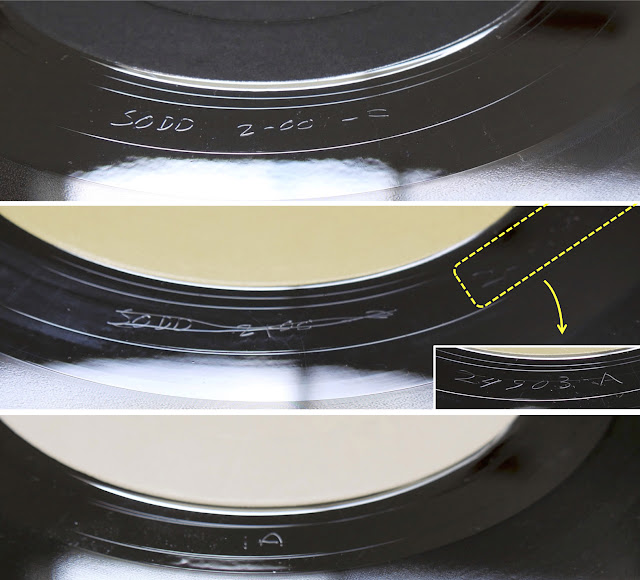 |
Obviously, Springsteen's facial shot by Eric Meola is the prototype of the Texaco-serviceman-guised drawing on the bootleg cover. On the right is an actual photo image featured on the interior of the famous Script Cover gatefold sleeve that houses the advanced U.S. promotional test pressing of BORN TO RUN LP (1/25/2015). The same picture was also used, as it is, for the cover image of another bootleg, LIVE AT THE BOTTOM LINE 8/15/75, released late in 1975 (8/11/2016). BTW, you may notice a small JASRAC sticker (a typical one from the mid-to-late 1970s; see 5/10/2018) on the bottom left corner of the bootleg. JASRAC stands for Japanese Society for Rights of Authors, Composers and Publishers, and the presence of its sticker means that the bootleg's content is officially licensed. But, then, how could this happen? Probably, JASRAC distributed the sticker to the import trader in response to the successful application for the license, who then put it on the album cover. In fact, here, we often see JASRAC-stickered copies of bootleg vinyl and CD imports. |
 | |
| Lahav's contribution has never been credited to Japanese BORN TO RUN LP. Shown are the labels and rear sleeves (part) of the probable last standard reissue in the U.S. from the 1990s (upper, Columbia JC 33795; see also 9/13/2015) and the final and fourth vinyl press in Japan from the mid-1980 (lower, CBS/SONY 25AP 1274) with the olive obi (inset). She has already been mentioned, though, on the rear sleeve of U.S. reissues since 1976-1977, just before Columbia Records' price code (= prefix of the catalog number) was changed from "PC" to "JC" (see 6/29/2016). |
When I started collecting unofficial live records in the summer of 1981, I had no idea there was a female band member who played violin for a short period in the past. Unlike the U.S. repressings (see 6/29/2016), by 1981 and until the end of the vinyl era, none of the Japanese vinyl releases, including the first (CBS/SONY SOPO-96; 5/14/2022) and three reissues (25AP 1274), credits Suki Lahav as playing violin on BORN TO RUN LP (see the images on the right). Then, I thought the string part was performed by an anonymous session musician or orchestra member. So, I never expected the concert to open with her stringed solo (of the intro to Incident On 57th Street), quickly assuming that it must be a live performance by someone else rather than Springsteen and the E Streeters.
No internet back then, and it was in November 1982 that I learned the details of the early band members and their history, including the temporal presence of the female violin player, when Dave Marsh's Born To Run: The Bruce Springsteen Story was first published in Japan by CBS/SONY Publishing, Inc.
However, the blame stopped here, and what followed and played on the two discs was full of magic and surprises by the man and his band members. Like many old-timers enthusiastic about vinyl Brucelegs in those days, I had become a bootleg addict, playing this double-vinyl set countless times, along with other classics such as PIÈCE DE RÉSISTANCE and LIVE IN THE PROMISED LAND, until the entire performance was released in 1990 on silver CD by Italy's Great Dane Records (THE SAINT, THE INCIDENT & THE MAIN POINT SHUFFLE: GDR CD 9012). Moreover, as I fell too deep into this bootleg, I realized that I also got favorably interested in that "crummy/ugly" artwork, even though back then, I knew neither what message the bootleg title originally conveyed (i.e., Texaco's advertising jingle from 1962) nor why Springsteen was drawn as "the man who wears the star (and holds something like a hose)."It's been so long since then, and even now, I occasionally take up one of these SODD copies from the record shelf and give it a listen for pure enjoyment, looking at the slick cover and wondering who drew it. Does anyone know?
— To be continued to Part 3 / back to Part 1.






